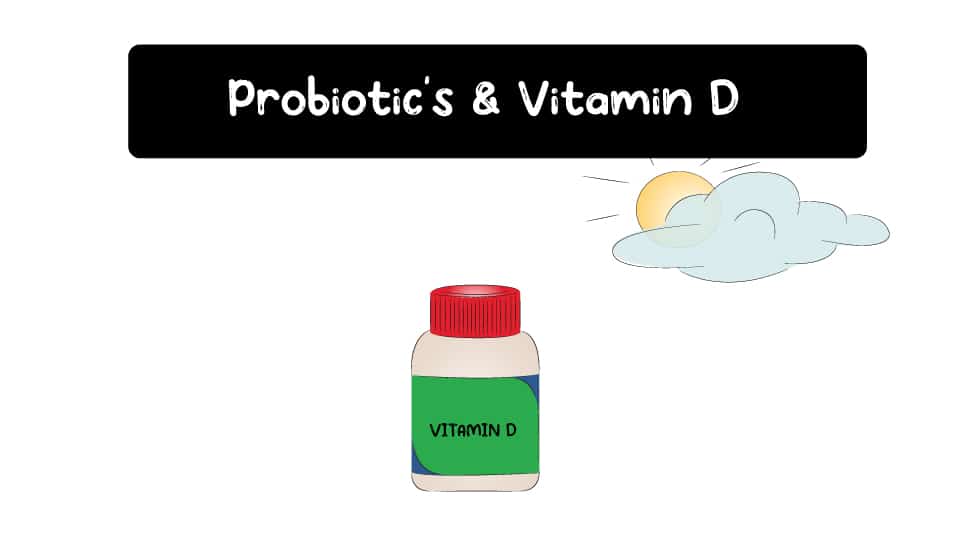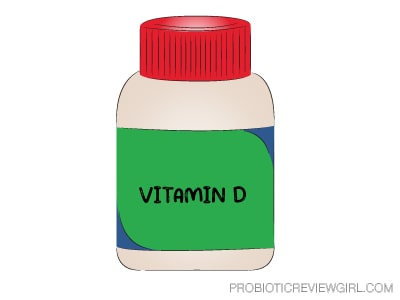Can Probiotics Aid Vitamin D Absorption?

Vitamin D is a fat-soluble nutrient essential for maintaining healthy bones, regulating calcium levels, and supporting various bodily functions, including immune system health. 14-59% of adults are thought to be deficient in Vitamin D according to the NIH.
Probiotics are live microorganisms, often referred to as "good bacteria," that provide potential health benefits when consumed by helping to balance and improve the gut microbiota. You can take Vitamin D and Probiotics together at the same time to help with Vitamin D absorption.
What Is Vitamin D?
Vitamin D, has crucial roles in the body, including aiding calcium and phosphate absorption for bone and teeth health, supporting immune function, and maintaining brain and nervous system health according to a 2008 study authored by N Khazai.
Vitamin D is a fat-soluble nutrient and hormone with important roles in the body. It aids in the absorption and retention of calcium and phosphate, which are essential for maintaining healthy bones, teeth, and muscles. The human body can produce vitamin D in response to sunlight exposure.
Vitamin D also supports the immune system, proper bone development, and nervous system function. Vitamin D deficiency can lead to various health issues, including bone problems. It is found naturally in a few foods and can be added to others. Different forms of vitamin D, such as D1, D2, and D3, contribute to its overall functions.
Can Probiotics Aid Vitamin D Absorption?
Yes, probiotics can aid in vitamin D absorption which is the process by which the body takes in and utilizes vitamin D from dietary sources, supplements, or sunlight exposure for various physiological functions.
A 2013 study authored by ML Jones, investigated the effects of the probiotic Lactobacillus reuteri NCIMB 30242 on fat-soluble vitamin absorption. While no significant differences were found in serum vitamin A, vitamin E, or β-carotene levels, the group taking probiotics showed a bigger rise in 25-hydroxyvitamin D levels (by 14.9 nmol/L, or 25.5%) compared to the placebo group's increase of 17.1 nmol/L, or 22.4%.
25-hydroxyvitamin D is a form of vitamin D found in the blood that serves as a marker to assess a person's vitamin D status. Taking the probiotic alongside a vitamin D supplement can lead to even greater increases in absorption levels. This suggests a potential synergy between probiotics and vitamin D supplementation.
Can You Take Probiotics And Vitamin D Together?

Yes you can take Vitamin D and Probiotics together at the same time without any problems. A 2019 study authored by V Ostad Mohammadi, found that combining vitamin D and probiotics could have a synergistic effects in patients with PCOS.
PCOS, or Polycystic Ovary Syndrome, is a common hormonal disorder characterized by irregular menstrual cycles, high levels of androgens (male hormones), and often the presence of enlarged ovaries with small cysts.
Probiotics and Vitamin D has the potential to improve mental health aspects, reduce inflammation and oxidative stress, and enhance vitamin D receptor expression. Vitamin D receptor expression refers to the amount and activity of cellular receptors that interact with vitamin D, influencing various biological processes regulated by this vitamin.
Can Vitamin D Help With Colds And Flus?
Yes, vitamin D supplementation could potentially have benefits in reducing the risk of colds and flu, particularly in individuals with low levels of vitamin D. Colds and flus are viral infections that primarily affect the respiratory system, causing symptoms such as congestion, cough, sore throat, fever, and body aches.
A 2020 study authored by WB Grant found that Vitamin D supplementation may play a role in reducing the risk of influenza. It points out that vitamin D can potentially lower viral replication rates, reduce inflammation, and enhance immune response. The study recommends considering vitamin D supplementation, especially during seasons when vitamin D levels are typically lower, as a potential measure to reduce infection risk.
Dr. Sara Mesilhy has a Master’s degree in Gastroenterology and holds a membership with the Royal College of Physicians of the United Kingdom. She completed her Bachelor of Medicine, Bachelor of Surgery (MBBS) at Cairo University and is currently part of the ProbioticReviewGirl medical team.